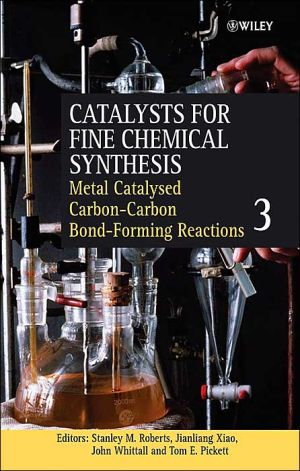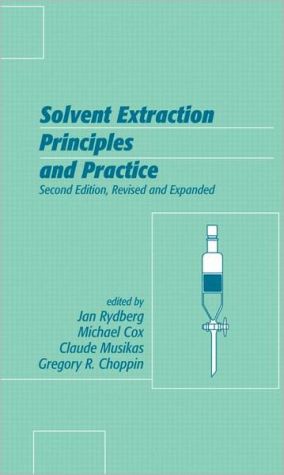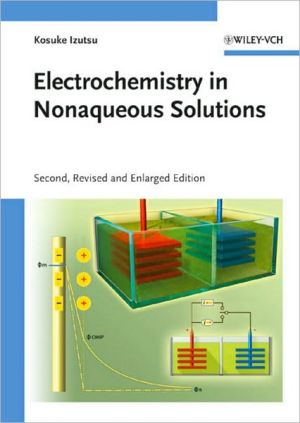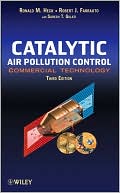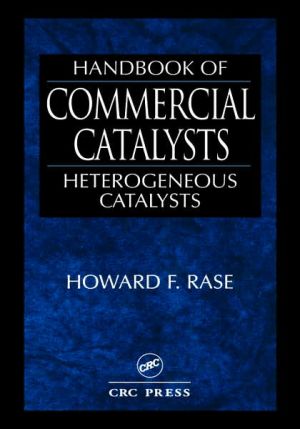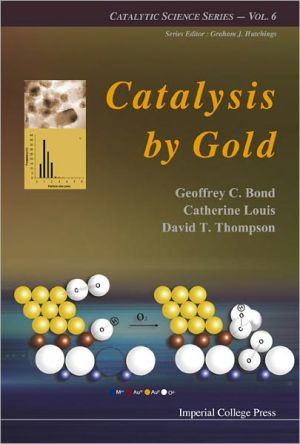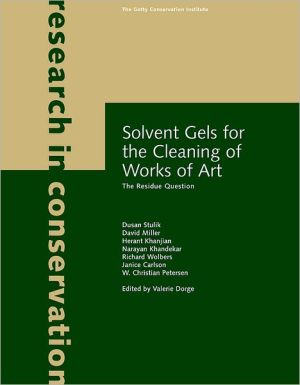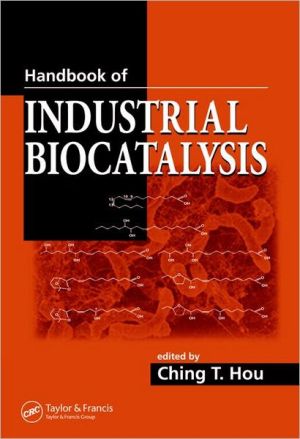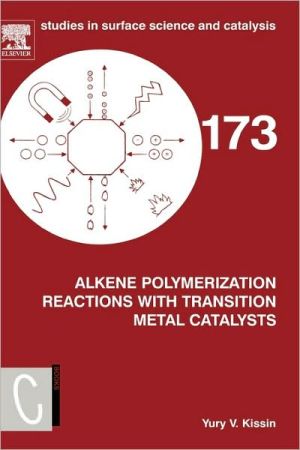Catalysts For Fine Chemical Sy
The chemist has a vast range of high-tech catalysts to use when working in fine chemical synthesis but the catalysts are generally hard to use and require both time, skill and experience to handle properly. The Catalysts for Fine Chemical Synthesis series contains tested and validated procedures which provide a unique range resources for chemists who work in organic chemistry.\ "... of great value to synthetic organic chemists..." (The Chemists, Summer 2003)\ Volume 3 in the...
Search in google:
Catalysts are increasingly used by chemists working in fine chemical synthesis in industry and academia. Today, there exists a huge choice of high-tech catalysts, which add enormously to the repertoire of synthetic possibilities. However, catalysts are tricky to use and require both skill and experience in order to achieve optimal results. This Series wants to be a practical help for advanced undergraduate, graduate and postgraduate students, and chemists in industry and academia working in organic and organometallic synthesis. The Series features:Tested and validated proceduresAuthorative reviews on classes of catalystsAssessments of all types of catalystsThe expertise from the Leverhulme Centre for Innovative Catalysis, Liverpool, UK.The formation of Carbon-Carbon bonds is one of the most important transformations used in the synthesis of fine chemicals. Catalysts promoting such transformations are in ever increasing demand. In this book the reader will find worked examples of a selection of Carbon-Carbon bond forming reactions including the asymmetric alkylation of aldehydes and ketones, the Michael and Pauson-Khand reactions, aldol protocols as well as hydroformylation and carboxylation. In addition to these well-established transformations, examples of relatively new methodologies are described, for example catalysts for olefin metathesis in organic synthesis are well represented. Furthermore in the light of the popularity of palladium-catalysed coupling reactions, some of the important Heck, Suzuki and Sonogashira catalysts are described in detail and their uses exemplified. In all chapters the preparative methods are accompanied by hints, tips and comments; safety issues are noted where appropriate. Booknews Reviews natural and non-natural catalysts for hydrolysis, oxidation, reduction, and carbon-carbon bond forming reactions leading to optically active products. The 13 chapters describe methods for asymmetric epoxidation of alkenes, asymmetric hydroxylation, asymmetric reduction of ketones, and asymmetric hydrogenation of carbon-carbon double bonds. For most of the reactions, there are several protocols on how to prepare and employ various catalysts, such as chiral modified diethylzinc, sulfoximine, and amino acid anions. Most of the protocols deal with non-natural catalysts because the corresponding biological procedures are featured in the sister volume, Preparative Biotransformations. Annotation c. Book News, Inc., Portland, OR
1Considerations of industrial fine chemical synthesis12Alkylation and allylation adjacent to a carbonyl group132.1The RuH[subscript 2](CO)(PPh[subscript 3])[subscript 3]-catalysed alkylation, alkenylation and arylation of aromatic ketones via carbon-hydrogen bond cleavage142.2Catalytic, asymmetric synthesis of [alpha],[alpha]-disubstituted amino acids using a chiral copper-salen complex as a phase transfer catalyst212.3Asymmetric phase-transfer catalysed alkylation of glycine imines using cinchona alkaloid derived quaternary ammonium salts273Asymmetric alkylation or amination of allylic esters353.1Synthesis and application in palladium-catalysed asymmetric allylic substitution of enantiopure cyclic [beta]-iminophosphine ligands363.2(9H,9'H,10H,10'H,11H,11H',13H,13'H,14H,14'H,15H,15'H -perfluorotricosane-12,12'-diyl)bis[(4s)-4-phenyl-2-oxazoline as a ligand for asymmetric palladium-catalysed alkylation of allylic acetates in fluorous media403.3Facile synthesis of new axially chiral diphosphine complexes for asymmetric catalysis473.4Chiral ferrocenyl-imino phosphines as ligands for palladium-catalysed enantioselective allylic alkylations514Suzuki coupling reactions594.1Palladium-catalysed borylation and Suzuki coupling (BSC) to obtain [beta]-benzo[b]thienyldehydroamino acid derivatives604.2Palladium-catalysed cross-coupling reactions of 4-tosylcoumarins and arylboronic acids : synthesis of 4-arylcoumarin compounds644.3Cyclopropyl arenes, alkynes and alkenes from the in situ generation of B-cyclopropyl-9-BBN and the Suzuki-Miyaura coupling of aryl, alkynyl and alkenyl bromides674.4One-pot synthesis of unsymmetrical 1,3-dienes through palladium-catalysed sequential borylation of a vinyl electrophile by a diboron and cross-coupling with a distinct vinyl electrophile704.5Pd(OAc)[subscript 2]/2-Aryl oxazoline catalysed Suzuki coupling reactions of aryl bromides and boronic acids744.6Palladium-catalysed reactions of haloaryl phosphine oxides : modular routes to functionalised ligands774.7Bulky electron rich phosphino-amines as ligands for the Suzuki coupling reaction of aryl chlorides814.8Arylation of ketones, aryl amination and Suzuki-Miyaura cross coupling using a well-defined palladium catalyst bearing an N-heterocyclic carbene ligand865Heck coupling reactions915.1Palladium-catalysed multiple and asymmetric arylations of vinyl ethers carrying co-ordinating nitrogen auxiliaries : synthesis of arylated ketones and aldehydes925.2Palladium-catalysed highly regioselective arylation of electron-rich olefins1005.31-[4-(S)-tert-Butyl-2-oxazolin-2-yl]-2-(S)-(diphenylphosphino) ferrocene as a ligand for the palladium-catalysed intermolecular asymmetric Heck reaction of 2,3-dihydrofuran1046Sonogashira coupling reactions1136.1Nonpolar biphasic catalysis : Suzuki- and Sonogashira coupling reactions1136.2Polystyrene-supported soluble palladacycle catalyst as recyclable catalyst for Heck, Suzuki and Sonogashira reactions1167Cross-coupling reactions1277.1Cross-coupling reaction of alkyl halides with Grignard reagents in the presence of 1,3-butadiene catalysed by nickel, palladium, or copper1287.2Triorganoindium compounds as efficient reagents for palladium-catalysed cross-coupling reactions with aryl and vinyl electrophiles1337.3Cross-coupling reactions catalysed by heterogeneous nickel-on-charcoal1387.4Carbon-carbon bond formation using arylboron reagents with rhodium(I) catalysts in aqueous media1478Regioselective or asymmetric 1,2-addition to aldehydes1558.1Development of a highly regioselective metal-mediated allylation reaction in aqueous media1568.2Boronic acids as aryl source for the catalysed enantioselective aryl transfer to aldehydes1618.3Jacobsen's Salen as a chiral ligand for the chromium-catalysed addition of 3-chloro-propenyl pivalate to aldehydes : a catalytic asymmetric entry to syn-akl-1-ene-3,4-diols1649Olefin metathesis reactions1699.1Highly active ruthenium (pre)catalysts for metathesis reactions1699.2A highly active and readily recyclable olefin metathesis catalyst1749.3Stereoselective synthesis of L-733,06017810Cyclisation reactions18110.1Molecular sieves as promoters for the catalytic Pauson-Khand reaction18210.2Palladium(II)-catalysed cyclization of alkynes with aldehydes, ketones or nitriles initiated by acetoxypalladation of alkynes18510.3Rhodium(I)-catalysed intramolecular alder-ene reaction and syntheses of functionalised [alpha]-methylene-[gamma]-butyrolactones and cyclopentanones19010.4Rhodium-catalysed [2+2+2] cyclotrimerisation in an aqueous-organic biphasic system19310.5Titanocene-catalysed transannular cyclisation of epoxygerm-acrolides : enantiospecific synthesis of eudesmanolides19611Asymmetric aldol and Michael reactions20111.1Direct catalytic asymmetric aldol reaction of a [alpha]-hydroxyketone promoted by an Et[subscript 2]Zn/linked-BINOL complex20211.2Highly enantioselective direct aldol reaction catalysed by a novel small organic molecule20811.3Direct catalytic asymmetric Michael reaction of [alpha]-hydroxyketone promoted by Et[subscript 2]Zn/linked-BINOL complex21011.4Catalytic enantioselective Michael reaction catalysed by well-defined chiral ruthenium-amido complexes21612Stereoselective hydroformylation, carbonylation and carboxylation reactions22512.1Ortho-diphenylphosphanylbenzoyl-(o-DPPB) directed diastereoselective hydroformylation of allylic alcohols22612.2The synthesis and application of ESPHOS : a new diphosphorus ligand for the hydroformylation of vinyl acetate23012.3Platinum-catalysed asymmetric hydroformylation of styrene23812.4Phosphine-free dimeric palladium (II) complex for the carbonylation of aryl iodides24412.5Carboxylation of pyrrole to pyrrole-2-carboxylate by cells of Bacillus megaterium in supercritical carbon dioxide247
\ From the Publisher"This reference provides detailed information for the preparation and use of relevant catalysts for the formation of carbon-carbon bonds." (Journal of the American Chemical Society, September 14, 2005)\ \ \
